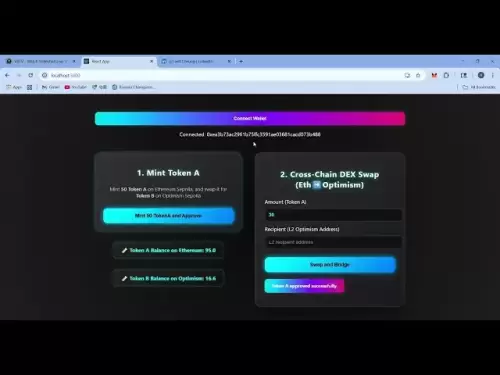-
 Bitcoin
Bitcoin $109,459.7682
2.44% -
 Ethereum
Ethereum $2,598.6052
6.29% -
 Tether USDt
Tether USDt $1.0003
0.00% -
 XRP
XRP $2.2734
3.95% -
 BNB
BNB $661.4886
1.58% -
 Solana
Solana $155.4825
4.35% -
 USDC
USDC $0.9999
-0.02% -
 TRON
TRON $0.2838
1.04% -
 Dogecoin
Dogecoin $0.1740
8.25% -
 Cardano
Cardano $0.6047
9.04% -
 Hyperliquid
Hyperliquid $40.2302
6.50% -
 Sui
Sui $2.9863
10.05% -
 Bitcoin Cash
Bitcoin Cash $509.5786
0.60% -
 Chainlink
Chainlink $13.8156
6.03% -
 UNUS SED LEO
UNUS SED LEO $9.0142
0.69% -
 Avalanche
Avalanche $19.0337
8.68% -
 Stellar
Stellar $0.2438
5.17% -
 Toncoin
Toncoin $2.9012
3.59% -
 Shiba Inu
Shiba Inu $0.0...01210
6.20% -
 Litecoin
Litecoin $90.0882
7.05% -
 Hedera
Hedera $0.1597
8.53% -
 Monero
Monero $326.3340
2.88% -
 Polkadot
Polkadot $3.6365
9.32% -
 Bitget Token
Bitget Token $4.6162
2.72% -
 Dai
Dai $1.0001
0.00% -
 Ethena USDe
Ethena USDe $1.0002
-0.01% -
 Uniswap
Uniswap $7.6403
10.47% -
 Pepe
Pepe $0.0...01060
12.03% -
 Aave
Aave $281.3664
7.56% -
 Pi
Pi $0.4992
1.76%
What does BitFlyer leverage trading mean
Leverage trading on BitFlyer offers enhanced potential profits but also heightens risks, emphasizing the need for calculated decision-making and cautious trading strategies.
Nov 20, 2024 at 02:31 am

Understanding BitFlyer Leverage Trading: A Comprehensive Guide
Introduction
BitFlyer, one of the leading cryptocurrency exchanges globally, offers leverage trading to its users. Leverage trading involves borrowing funds from the exchange to amplify trading positions, enabling traders to potentially maximize their profits. However, it also increases the risk of substantial losses if not managed properly.
What is Leverage Trading?
Leverage trading is a type of trading that allows traders to magnify their trading positions by borrowing funds from a broker or exchange. It is commonly expressed as a ratio, such as 10x, 50x, or 100x. For instance, with 10x leverage, a trader can control a position worth $10,000 with only $1,000 of their own funds. This significantly amplifies the potential returns but also the potential losses.
How Does BitFlyer Leverage Trading Work?
BitFlyer's leverage trading platform allows traders to borrow funds from the exchange in order to increase the size of their trading positions. The exchange offers varying leverage ratios depending on the specific cryptocurrency pair being traded. Traders can choose their desired leverage ratio when opening a leverage trading account.
Benefits of BitFlyer Leverage Trading
- Enhanced potential profits: Leverage trading magnifies the potential profits that can be made from trading cryptocurrencies. By borrowing funds from the exchange, traders can control larger positions and amplify their gains.
- Increased flexibility: Leverage trading provides traders with greater flexibility in managing their risk and potential rewards. They can adjust their leverage ratio based on their risk tolerance and market conditions.
- Trading opportunities: Leverage trading opens up additional trading opportunities that may not be available with limited capital. Traders can take advantage of smaller market movements and potentially make significant profits.
Risks of BitFlyer Leverage Trading
- Increased risk: Leverage trading significantly increases the risk of incurring losses. If the market moves against the trader's position, they could lose more funds than they initially invested.
- Margin calls: If the value of the trader's position falls below a certain threshold, known as the margin call level, the exchange may force the trader to close their position or provide additional funds to maintain the margin requirement. Failure to meet a margin call can result in liquidation of the trader's position.
- Emotional trading: Leverage trading can lead to emotional trading, as traders may feel pressured to make quick decisions to avoid substantial losses. This can jeopardize their trading strategy and lead to poor decision-making.
How to Use BitFlyer Leverage Trading
- Open a leverage trading account: To engage in leverage trading on BitFlyer, traders must create a separate leverage trading account. They will need to provide additional information and undergo a risk assessment process.
- Choose a trading pair and leverage ratio: Traders need to select the cryptocurrency pair they wish to trade and choose an appropriate leverage ratio. Higher leverage ratios increase both potential profits and risks.
- Place a trade order: Traders can place buy or sell orders with leverage on BitFlyer's trading interface. They can specify the amount of funds they wish to borrow and the leverage ratio they desire.
- Manage open positions: Once a leveraged trade is opened, traders must closely monitor their positions and manage their risk. They can adjust their leverage ratio or close their positions if market conditions warrant.
- Meet margin requirements: Traders must ensure they maintain sufficient margin in their account to cover potential losses on their leveraged positions. Failure to meet margin requirements may trigger a margin call or liquidation of their positions.
Choosing the Right Leverage Ratio
Selecting the appropriate leverage ratio is crucial for effective leverage trading. The optimal ratio depends on the trader's risk tolerance, trading strategy, and market volatility.
- Low leverage (2x-5x): Suitable for conservative traders with a lower risk tolerance. Lower leverage ratios reduce potential losses but also limit potential profits.
- Medium leverage (10x-25x): Balanced approach for traders with more experience and a moderate risk tolerance. Medium leverage ratios provide a fair balance between potential profits and risks.
- High leverage (50x-100x): Requires a high level of risk tolerance and trading skill. High leverage ratios greatly amplify both potential profits and risks, so they should be used with extreme caution.
Tips for Successful Leverage Trading on BitFlyer
- Understand the risks: Thoroughly comprehend the potential risks associated with leverage trading before engaging in it.
- Develop a trading strategy: Plan your trades carefully and adhere to a clearly defined trading strategy that aligns with your risk tolerance and trading objectives.
- Manage emotions: Avoid making impulsive trades based on fear or greed. Emotional trading can lead to poor decision-making and losses.
- Set stop-loss orders: Implement stop-loss orders to limit potential losses automatically if the market moves against your position.
- Continuously educate yourself: Stay updated on market trends, trading techniques, and risk management strategies to enhance your leverage trading acumen.
Disclaimer:info@kdj.com
The information provided is not trading advice. kdj.com does not assume any responsibility for any investments made based on the information provided in this article. Cryptocurrencies are highly volatile and it is highly recommended that you invest with caution after thorough research!
If you believe that the content used on this website infringes your copyright, please contact us immediately (info@kdj.com) and we will delete it promptly.
- Altcoin Alert: Binance Listings and the Wild West of Crypto
- 2025-07-03 14:30:11
- Decentralized Stablecoins in 2025: Challenging Centralized Counterparts?
- 2025-07-03 14:30:11
- Meme Coin Mania: Is BTC Bull the Next Big Thing in a Limited Time BTC Bull Run?
- 2025-07-03 12:30:11
- Bitcoin Soars to $109,000: What's Fueling the Crypto Rally?
- 2025-07-03 10:30:13
- Hong Kong: Racing to Be the World's Tokenization Hub
- 2025-07-03 14:50:11
- Splatterhouse Rocks Retro Scene: A UK Magazine Deep Dive
- 2025-07-03 12:30:11
Related knowledge

How to identify the contract value range in combination with the market profile?
Jul 02,2025 at 10:56pm
Understanding the Market ProfileTo effectively identify the contract value range in combination with the market profile, it's essential to first understand what each concept entails. The market profile is a framework that helps traders visualize how price and time interact across a given period, typically a trading day or session. It provides insights i...

How to use the price slope to filter the false breakthrough signal of the contract?
Jun 20,2025 at 06:56pm
Understanding the Concept of Price Slope in Contract TradingIn contract trading, especially within cryptocurrency derivatives markets, price slope refers to the rate at which the price changes over a specific time period. It helps traders assess the strength and sustainability of a trend. A steep slope may indicate strong momentum, while a shallow slope...

How to determine the expected volatility of the contract through the volatility cone?
Jun 19,2025 at 12:28pm
Understanding the Basics of Volatility in Cryptocurrency ContractsIn the realm of cryptocurrency trading, volatility is a key metric that traders use to assess potential risk and reward. When dealing with futures contracts, understanding how volatile an asset might become over time is crucial for position sizing, risk management, and strategy developmen...

How to formulate a contract intraday trading plan in combination with the pivot point system?
Jun 21,2025 at 03:42pm
Understanding the Basics of Pivot Points in Cryptocurrency TradingPivot points are technical analysis tools used by traders to identify potential support and resistance levels. These levels are calculated using the previous day's high, low, and closing prices. In the context of cryptocurrency trading, where markets operate 24/7, pivot points help trader...

How to adjust the contract position ratio through the price fluctuation entropy?
Jun 22,2025 at 11:42am
Understanding Price Fluctuation Entropy in Cryptocurrency ContractsIn the world of cryptocurrency futures trading, price fluctuation entropy is a relatively new concept used to measure market volatility and uncertainty. It derives from information theory, where entropy refers to the degree of randomness or unpredictability in a system. In crypto contrac...

How to use the volume swing indicator to predict the contract volume-price divergence?
Jun 18,2025 at 11:42pm
Understanding the Volume Swing IndicatorThe volume swing indicator is a technical analysis tool used primarily in cryptocurrency trading to evaluate changes in volume over time. Unlike price-based indicators, this metric focuses solely on trading volume, which can provide early signals about potential market reversals or continuations. The key idea behi...

How to identify the contract value range in combination with the market profile?
Jul 02,2025 at 10:56pm
Understanding the Market ProfileTo effectively identify the contract value range in combination with the market profile, it's essential to first understand what each concept entails. The market profile is a framework that helps traders visualize how price and time interact across a given period, typically a trading day or session. It provides insights i...

How to use the price slope to filter the false breakthrough signal of the contract?
Jun 20,2025 at 06:56pm
Understanding the Concept of Price Slope in Contract TradingIn contract trading, especially within cryptocurrency derivatives markets, price slope refers to the rate at which the price changes over a specific time period. It helps traders assess the strength and sustainability of a trend. A steep slope may indicate strong momentum, while a shallow slope...

How to determine the expected volatility of the contract through the volatility cone?
Jun 19,2025 at 12:28pm
Understanding the Basics of Volatility in Cryptocurrency ContractsIn the realm of cryptocurrency trading, volatility is a key metric that traders use to assess potential risk and reward. When dealing with futures contracts, understanding how volatile an asset might become over time is crucial for position sizing, risk management, and strategy developmen...

How to formulate a contract intraday trading plan in combination with the pivot point system?
Jun 21,2025 at 03:42pm
Understanding the Basics of Pivot Points in Cryptocurrency TradingPivot points are technical analysis tools used by traders to identify potential support and resistance levels. These levels are calculated using the previous day's high, low, and closing prices. In the context of cryptocurrency trading, where markets operate 24/7, pivot points help trader...

How to adjust the contract position ratio through the price fluctuation entropy?
Jun 22,2025 at 11:42am
Understanding Price Fluctuation Entropy in Cryptocurrency ContractsIn the world of cryptocurrency futures trading, price fluctuation entropy is a relatively new concept used to measure market volatility and uncertainty. It derives from information theory, where entropy refers to the degree of randomness or unpredictability in a system. In crypto contrac...

How to use the volume swing indicator to predict the contract volume-price divergence?
Jun 18,2025 at 11:42pm
Understanding the Volume Swing IndicatorThe volume swing indicator is a technical analysis tool used primarily in cryptocurrency trading to evaluate changes in volume over time. Unlike price-based indicators, this metric focuses solely on trading volume, which can provide early signals about potential market reversals or continuations. The key idea behi...
See all articles

























































































